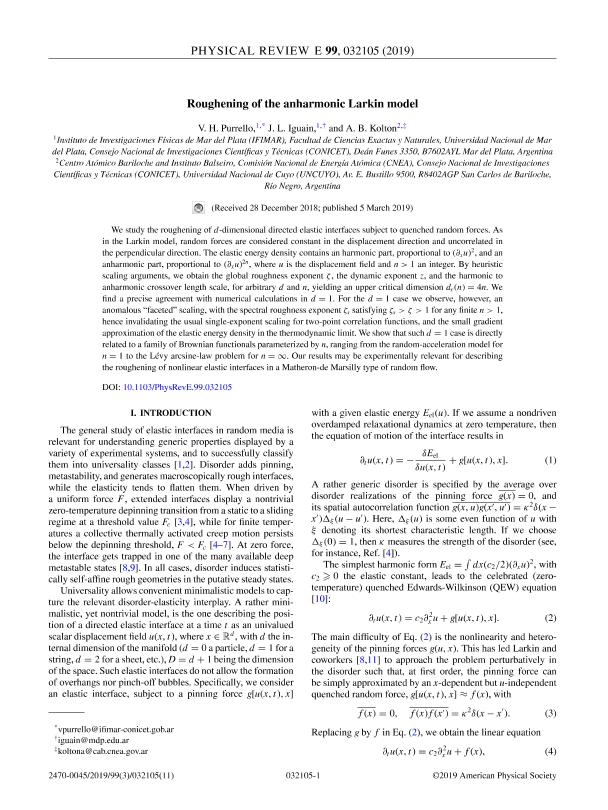Artículo
Roughening of the anharmonic Larkin model
Fecha de publicación:
03/2019
Editorial:
American Physical Society
Revista:
Physical Review E
ISSN:
2470-0045
e-ISSN:
2470-0053
Idioma:
Inglés
Tipo de recurso:
Artículo publicado
Clasificación temática:
Resumen
We study the roughening of d-dimensional directed elastic interfaces subject to quenched random forces. As in the Larkin model, random forces are considered constant in the displacement direction and uncorrelated in the perpendicular direction. The elastic energy density contains an harmonic part, proportional to (∂xu)2, and an anharmonic part, proportional to (∂xu)2n, where u is the displacement field and n>1 an integer. By heuristic scaling arguments, we obtain the global roughness exponent ζ, the dynamic exponent z, and the harmonic to anharmonic crossover length scale, for arbitrary d and n, yielding an upper critical dimension dc(n)=4n. We find a precise agreement with numerical calculations in d=1. For the d=1 case we observe, however, an anomalous "faceted" scaling, with the spectral roughness exponent ζs satisfying ζs>ζ>1 for any finite n>1, hence invalidating the usual single-exponent scaling for two-point correlation functions, and the small gradient approximation of the elastic energy density in the thermodynamic limit. We show that such d=1 case is directly related to a family of Brownian functionals parameterized by n, ranging from the random-acceleration model for n=1 to the Lévy arcsine-law problem for n=∞. Our results may be experimentally relevant for describing the roughening of nonlinear elastic interfaces in a Matheron-de Marsilly type of random flow.
Palabras clave:
Critical phenomena
,
Elasticity
,
Roughness
,
Random & disordered media
Archivos asociados
Licencia
Identificadores
Colecciones
Articulos(IFIMAR)
Articulos de INST.DE INVESTIGACIONES FISICAS DE MAR DEL PLATA
Articulos de INST.DE INVESTIGACIONES FISICAS DE MAR DEL PLATA
Citación
Purrello, Víctor Hugo; Iguain, Jose Luis; Kolton, Alejandro Benedykt; Roughening of the anharmonic Larkin model; American Physical Society; Physical Review E; 99; 3; 3-2019; 1-11
Compartir
Altmétricas




